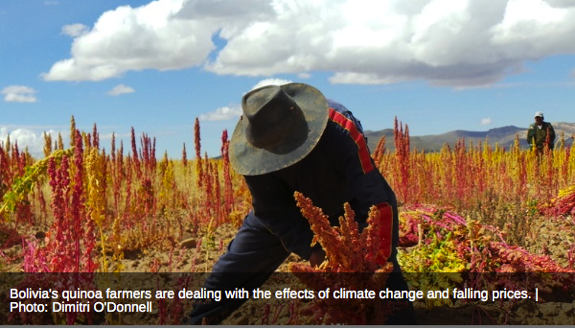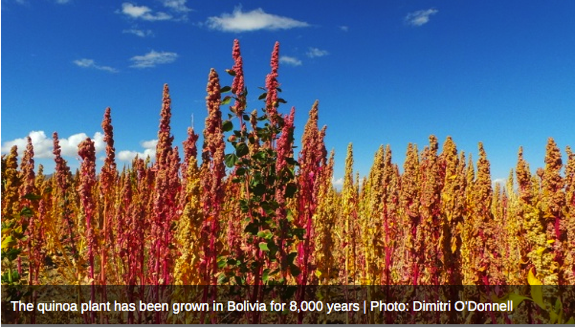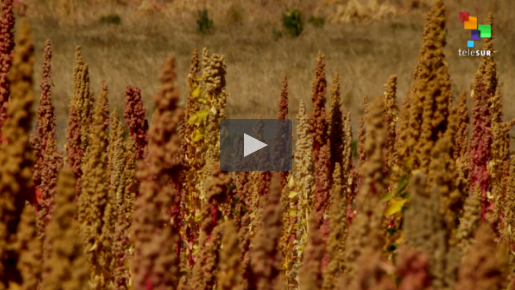

Falling Quinoa Prices Hit Bolivian Farmers Hard
April 8, 2016 - telesurtv.net
Prices have fallen up to 80 percent at local markets and the value of international exports have almost halved in a year.
It's been a tough start to the year for Bolivia's quinoa farmers.
They've been struggling to grow the crop because of the effects of climate change and the weather phenomenon of El Nino.
In the town of Patacayma in the altiplano, near La Paz, farmers are dealing with unprecedented challenges.
Thousands of hectares of land is set aside in this part of the country for growing the quinoa plant. For several kilometers there's field after field of colorful quinoa plants, illuminating the parched landscape in bright reds, rustic yellows and earthy browns.
It makes for a beautiful sight. But for older farmers like Florenicio Nina, who's been growing quinoa for just three years, all he can see is dwindling profits.
"Climate change is really hurting us," Florencino told me as he frantically chopped down his quinoa plants.
"There's less rain here this year, we need some rain to grow the plant."
The plants that have survived this harsh dry spell are less colorful and don't have the same quality as those that flourish in perfect conditions.
"Look at this one!" Florencino motions to me to see for myself the condition of his quinoa crop. "It's grown alright but there's hardly any quinoa, I can't sell this," he said, sighing in frustration.
WATCH: Bolivian Quinoa Farmers Face Crisis
Press on picture to go to video

Florencino isn't the only farmer struggling to adapt to this new reality.
In a neighboring farm Valerio Mamani is also hard at work cultivating his quinoa crop. "When I started out at 18, the quinoa plant would grow as tall as I am," he said."
Now 36 and a father of a three-year-old daughter, Valerio reports that "climate change has ruined everything."
"Now the plants are much smaller, harder to grow, the quality of the seed is affected by the unpredictable weather," Valerio told teleSUR.
Families like the Mamani's are also getting to grips with another harsh reality, the rapidly declining price of quinoa both domestically and internationally.
Ten years ago quinoa farming took off on a large scale prompted by the global demand for quinoa.
Western nations became infatuated with this humble Bolivian grain, grown and eaten in the Andean nation for 8,000 years.
Quinoa is gluten-free and contains twice the protein content of rice or barley. Quinoa is also a very good source of calcium, magnesium and manganese, while possessing high levels of several B vitamins, vitamin E and dietary fiber.
As international demand soared Bolivian farmers invested all their money into cultivating the plant. They turned over the majority of their land to growing the plant.
"It became very profitable very quickly for farmers to produce quinoa and make a good profit," said Edgar Soliz Morales of the International Center For Quinoa, based in La Paz.
Between 2006 and 2012 the price of the grain tripled in value.
But this year farmers have learned to their cost that an overdependence on one commodity is profitable only in the short-term.
"Prices at the local market have dropped by as much as 70 percent," Cristobal Mamani Nina, a local quinoa representative, told teleSUR. "We are all worried,"
The impact in the fall of prices has been felt in small communities like Patacayma that depend heavily on a good season and a stable price to make a living.
But so far all 2016 has brought is a double whammy of misfortune.
Neighboring Peru is now the largest quinoa producer in the world and also the main exporter of the grain to the lucrative U.S. market.
50 percent of Bolivian exports used to go to the U.S. worth several millions of dollars in revenue for the country.
The value of international exports has dropped 46 percent in a year. It's desperate times for quinoa farmers.
"We need help," said young farmer Valerio Mamani. "What if the quinoa returns to the price it was before, when we got just US$8-10 for every 100 kgs."
This is a real concern for farmers who have invested everything in quinoa production.
"Bread costs almost 50 cents. I will no longer make enough to cover my child's education and to support ourselves throughout the year,'' Valerio told teleSUR.
Quinoa farming is hard work. Farmers toil in the fields, under soaring temperatures from 8 a.m. until 6 p.m. with just an hour's break every day.
But even with the challenges of climate change, falling prices and bruised egos over losing ground to Peru, Bolivian farmers say they will soldier on regardless. "We have no other choice," said Valerio. "We have to feed our families."